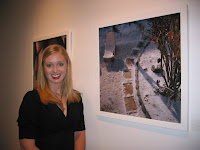November 9th was the closing reception for the joint MFA Thesis show of Sarah Jones, The Anchorage and Katharine Wright, Decay Constant at Alexander Hall in Savannah, Ga. This joining of two very different bodies of work was an amazing choice by the two artists because, despite the fact they are so different in visual style, they are similar in content.

Jones’s work documents the ‘compulsive nature of collecting, which in turn reveals a great deal about the collectors themselves.’ Her photographs were all taken at her grandparents homestead name The Anchorage and depicted everything from piles of books and boxes to quarters in egg crates, family photos and a Southern stable, the Confederate flag, which is, according to the artist, “heritage not hatred.” Like the generations before us who had seen hard times and knew the value fixing something instead of buying new, Jones’s grandparents were afraid to let any thing go for the possibility that it might be of use someday. The images ranged form postcards to posters in size and were hung salon style. Jones choice in frames, mismatched and aged wood, is a great addition to the work, giving the viewer the feeling that these images had been pulled from the house itself. Totaling in almost 50 images, it seems that Jones would be commenting on the collecting nature of her grandparents by collecting images of their decaying home.

 Wright’s work is an investigation of ‘her world and the anxiety she feels about …the eventual loss of those closest to her.’ Done in a poetic manner with unusual cropping, Wright depicts those people and moments around her that, with her camera, she attempts to hold on to. The title alone Decay Constant suggest continual change and Wright is comment on the photograph’s nature to freeze time and become a surrogate. She expresses this concept further with her instillation pieces and with their choice of medium, wax, ice and formaldehyde. In glass jars, these substances hold something precious, such as a love letter, and try to preserve it, but in doing so have, in a way, ruined the object it was supposed to protect.
Wright’s work is an investigation of ‘her world and the anxiety she feels about …the eventual loss of those closest to her.’ Done in a poetic manner with unusual cropping, Wright depicts those people and moments around her that, with her camera, she attempts to hold on to. The title alone Decay Constant suggest continual change and Wright is comment on the photograph’s nature to freeze time and become a surrogate. She expresses this concept further with her instillation pieces and with their choice of medium, wax, ice and formaldehyde. In glass jars, these substances hold something precious, such as a love letter, and try to preserve it, but in doing so have, in a way, ruined the object it was supposed to protect.

Both Jones’s and Wright’s show comment on our ever changes world and the ways in which we try to hold on to our collective past. There is, in both series, a sense of loss that that the artist is trying to evade by using objects as surrogate for the people closest to them and their own fond memories.





















